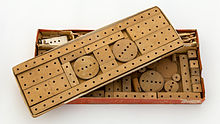
A brick is a type of construction material used to build walls, pavements and other elements in masonry construction. Properly, the term brick denotes a unit primarily composed of clay, but is now also used informally to denote units made of other materials or other chemically cured construction blocks. Bricks can be joined using mortar, adhesives or by interlocking. Bricks are usually produced at brickworks in numerous classes, types, materials, and sizes which vary with region, and are produced in bulk quantities.
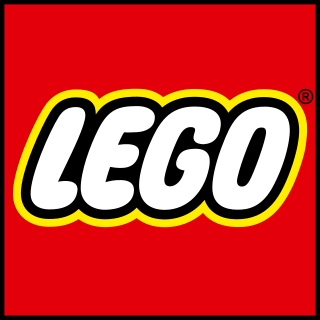
Lego is a line of plastic construction toys manufactured by the Lego Group, a privately held company based in Billund, Denmark. Lego consists of variously coloured interlocking plastic bricks made of acrylonitrile butadiene styrene (ABS) that accompany an array of gears, figurines called minifigures, and various other parts. Its pieces can be assembled and connected in many ways to construct objects, including vehicles, buildings, and working robots. Assembled Lego models can be taken apart, and their pieces can be reused to create new constructions.

Masonry is the craft of building a structure with brick, stone, or similar material, including mortar plastering which are often laid in, bound and pasted together by mortar. The term masonry can also refer to the building units themselves.
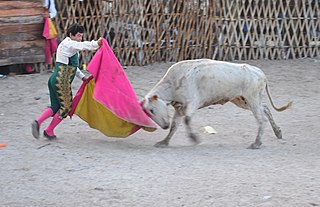
A bullfighter is a performer in the activity of bullfighting. Torero or toureiro, both from Latin taurarius, are the Spanish and Portuguese words for bullfighter, and describe all the performers in the activity of bullfighting as practised in Spain, Portugal, Mexico, Peru, France, Colombia, Ecuador, Venezuela and other countries influenced by Portuguese and Spanish culture. The main performer and leader of the entourage in a bullfight, and who finally kills the bull, is addressed as maestro (master), or with the formal title matador de toros. The other bullfighters in the entourage are called subalternos and their suits are embroidered in silver as opposed to the matador's gold. They include the picadores, rejoneadores, and banderilleros.

A clapperboard, also known as a dumb slate, clapboard, film clapper, film slate, movie slate, or production slate, is a device used in filmmaking and video production to assist in synchronizing of picture and sound, and to designate and mark the various scenes and takes as they are filmed and audio-recorded. It is operated by the clapper loader. It is said to have been invented by Australian filmmaker F. W. Thring. Due to its ubiquity on film sets, the clapperboard is frequently featured in behind-the-scenes footage and films about filmmaking, and has become an enduring symbol of the film industry as a whole.

The ancient Romans were the first civilization to build large, permanent bridges. Early Roman bridges used techniques introduced by Etruscan immigrants, but the Romans improved those skills, developing and enhancing methods such as arches and keystones. There were three major types of Roman bridge: wooden, pontoon, and stone. Early Roman bridges were wooden, but by the 2nd century stone was being used. Stone bridges used the arch as their basic structure, and most used concrete, the first use of this material in bridge-building.
A hockey stick is a piece of sports equipment used by the players in all the forms of hockey to move the ball or puck either to push, pull, hit, strike, flick, steer, launch or stop the ball/puck during play with the objective being to move the ball/puck around the playing area using the stick, and then trying to score.

The manipulation of the devil stick is a form of gyroscopic juggling or equilibristics, consisting of manipulating one stick between one or two other sticks held one in each hand. The baton is lifted, struck, or stroked by the two control sticks, stabilizing the baton through gyroscopic motion.
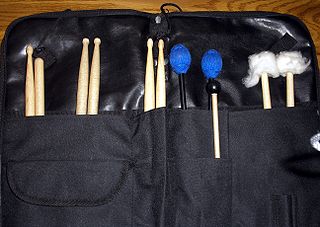
A percussion mallet or beater is an object used to strike or beat a percussion instrument in order to produce its sound.

The Tinkertoy Construction Set—commonly known as Tinkertoy, Tinker Toy, or plural forms thereof—is a construction set for children. It was designed in 1914 and was originally manufactured in Evanston, Illinois, U.S. The brand is now owned by Hasbro.

A slapshot is a powerful shot in ice hockey. Its advantage is as a high-speed shot that can be taken from a long distance; the disadvantage is the long time to set it up as well as its low accuracy.
The history of Lego began in 1932 in the carpentry workshop of Ole Kirk Christiansen, a Danish carpenter who initially produced furniture but later started making wooden toys. The company was named "Lego" in 1934, a contraction from the Danish phrase "leg godt", meaning "play well".

Toy blocks are wooden, plastic, or foam pieces of various shapes and colors that are used as construction toys. Sometimes, toy blocks depict letters of the alphabet.
Struck idiophones is one of the categories of idiophones that are found in the Hornbostel-Sachs system of musical instrument classification.

The Architecture of Cesar Department refers to the architecture in the Cesar Department of Colombia, which still preserves much of the colonial architecture inherited by the Spanish colonization and the architecture developed by the numerous tribes of indigenous peoples of the Cesar Department that included the Tairona, Chimila, Motilon and Kalina.

The Fayette County Courthouse is a historic courthouse building located at 110 East Court Street in Washington Court House, Ohio. On July 2, 1973, it was added to the National Register.

Indigenous North American stickball is a team sport typically played on an open field where teams of players with two sticks each attempt to control and shoot a ball at the opposing team's goal. It shares similarities to the game of lacrosse. In Choctaw Stickball, "Opposing teams use handcrafted sticks, or kabocca, and a woven leather ball, or towa. Each team tries to advance the ball down the field to the other team's goalpost using only their sticks, never touching or throwing the ball with their hands. Points are scored when a player hits the opposing team's goalpost with the ball."
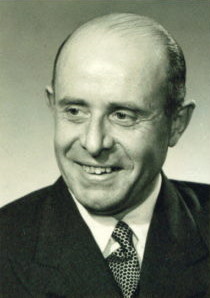
Hilary "Harry" Fisher Page was an English toy maker and inventor of Self-Locking Building Bricks, the predecessor of Lego bricks. He founded the Kiddicraft toy company.

The Weinmann Block is a commercial building located at 219-223 East Washington Street in Ann Arbor, Michigan. It was listed on the National Register of Historic Places in 1983.

A yoga brick or yoga block is a smooth block of wood or of firm but comfortable material, such as hard foam rubber or cork, used as a prop in yoga as exercise.


